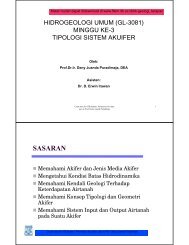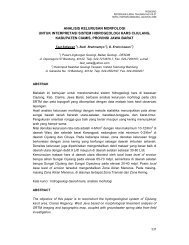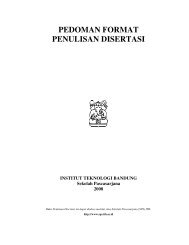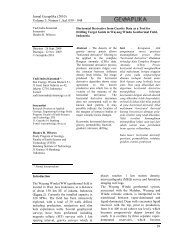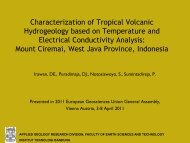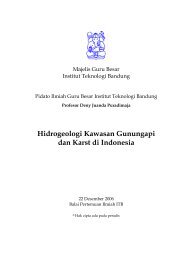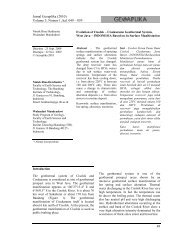Hydrogeochemistry of volcanic hydrogeology based on cluster ... - ITB
Hydrogeochemistry of volcanic hydrogeology based on cluster ... - ITB
Hydrogeochemistry of volcanic hydrogeology based on cluster ... - ITB
- No tags were found...
Create successful ePaper yourself
Turn your PDF publications into a flip-book with our unique Google optimized e-Paper software.
Journal <str<strong>on</strong>g>of</str<strong>on</strong>g> Hydrology 376 (2009) 221–234C<strong>on</strong>tents lists available at ScienceDirectJournal <str<strong>on</strong>g>of</str<strong>on</strong>g> Hydrologyjournal homepage: www.elsevier.com/locate/jhydrol<str<strong>on</strong>g>Hydrogeochemistry</str<strong>on</strong>g> <str<strong>on</strong>g>of</str<strong>on</strong>g> <str<strong>on</strong>g>volcanic</str<strong>on</strong>g> <str<strong>on</strong>g>hydrogeology</str<strong>on</strong>g> <str<strong>on</strong>g>based</str<strong>on</strong>g> <strong>on</strong> <strong>cluster</strong> analysis<str<strong>on</strong>g>of</str<strong>on</strong>g> Mount Ciremai, West Java, Ind<strong>on</strong>esiaDasapta Erwin Irawan a, *, Deny Juanda Puradimaja a , Sudarto Notosiswoyo b , Prihadi Soemintadiredja aa Research Group <strong>on</strong> Applied Geology, Faculty <str<strong>on</strong>g>of</str<strong>on</strong>g> Earth Sciences and Technology, Institut Teknologi Bandung, Jl. Ganesha No. 10, 40132 Bandung, Ind<strong>on</strong>esiab Research Group <strong>on</strong> Earth Resources Explorati<strong>on</strong>, Faculty <str<strong>on</strong>g>of</str<strong>on</strong>g> Mining and Petroleum Engineering, Institut Teknologi Bandung, Jl. Ganesha No. 10, 40132 Bandung, Ind<strong>on</strong>esiaarticleinfosummaryArticle history:Received 22 July 2008Received in revised form 9 July 2009Accepted 11 July 2009This manuscript was handled by L. Charlet,Editor-in-Chief, with the assistance <str<strong>on</strong>g>of</str<strong>on</strong>g> ShengYue, Associate EditorKeywords:HydrochemistryVolcanic <str<strong>on</strong>g>hydrogeology</str<strong>on</strong>g>Multivariate analysisHydrogeochemical analysis has been c<strong>on</strong>ducted <strong>on</strong> 119 spring locati<strong>on</strong>s to portray <str<strong>on</strong>g>volcanic</str<strong>on</strong>g> hydrogeologicalsystem <str<strong>on</strong>g>of</str<strong>on</strong>g> Mount Ciremai, West Java, Ind<strong>on</strong>esia. Cluster analysis <strong>on</strong> 14 parameters has extracted three<strong>cluster</strong>s. Cluster 1 (112 springs) is distinguished by normal temperatures, low TDS, EC, and high bicarb<strong>on</strong>atec<strong>on</strong>centrati<strong>on</strong>s. Cluster 2 (five springs) has moderately high temperature, TDS, EC, and high c<strong>on</strong>centrati<strong>on</strong><str<strong>on</strong>g>of</str<strong>on</strong>g> chloride. Cluster 3 (two springs) exhibits high temperature, anomalous high TDS, EC, andchloride c<strong>on</strong>centrati<strong>on</strong>.Three hydrogeological systems have been pictured <str<strong>on</strong>g>based</str<strong>on</strong>g> <strong>on</strong> the 3 <strong>cluster</strong>s c<strong>on</strong>secutively. The 1st systemis developed in shallow unc<strong>on</strong>fined aquifer, with dominati<strong>on</strong> <str<strong>on</strong>g>of</str<strong>on</strong>g> high bicarb<strong>on</strong>ate (4.2 me/L) meteoricwater. The 2nd system is predominated with mixing processes, between groundwater in unc<strong>on</strong>finedaquifer and hot groundwater from deeper aquifers. The 3rd system is primarily dominated by groundwaterflow from deep formati<strong>on</strong>. The hot – deep seated groundwater flow also carries mud particles. It hasanomalous high TDS (>1000 mg/L), EC (515 lS/cm), and chloride (99 me/L) from interacti<strong>on</strong> betweengroundwater with clay formati<strong>on</strong>s, interpreted as Kaliwangu Formati<strong>on</strong>.Ó 2009 Elsevier B.V. All rights reserved.Introducti<strong>on</strong>Problem statement and objectiveInd<strong>on</strong>esia is part <str<strong>on</strong>g>of</str<strong>on</strong>g> ring <str<strong>on</strong>g>of</str<strong>on</strong>g> fire, in form <str<strong>on</strong>g>of</str<strong>on</strong>g> <str<strong>on</strong>g>volcanic</str<strong>on</strong>g> belt with almost128 volcanoes or 13–17% <str<strong>on</strong>g>of</str<strong>on</strong>g> total volcanoes in the world. The<str<strong>on</strong>g>volcanic</str<strong>on</strong>g> belt with focussing <strong>on</strong> Java Island is presented in Fig. 1.These volcanoes produce <str<strong>on</strong>g>volcanic</str<strong>on</strong>g> deposit cover a total area <str<strong>on</strong>g>of</str<strong>on</strong>g>33,000 km 2 or <strong>on</strong>e sixth <str<strong>on</strong>g>of</str<strong>on</strong>g> Ind<strong>on</strong>esia’s land (Dept. <str<strong>on</strong>g>of</str<strong>on</strong>g> Mining andEnergy, 1979). In terms <str<strong>on</strong>g>of</str<strong>on</strong>g> <str<strong>on</strong>g>hydrogeology</str<strong>on</strong>g>, the <str<strong>on</strong>g>volcanic</str<strong>on</strong>g> deposits performas productive aquifer. Such high productivity is shown by theemergence <str<strong>on</strong>g>of</str<strong>on</strong>g> spring belt at the foot slopes with enormous dischargeand excellent quality. The aquifers come as porous systemas well as fracture system. For example, at Ciremai volcano, thereare at least 119 springs with variable discharge, from 10 L/s t<strong>on</strong>early 100 L/s (Bapeda Kuningan, 2002).This paper describes a hydrogeological assessment method toextract the geological c<strong>on</strong>trol to groundwater springs. It is importantin order to build a c<strong>on</strong>ceptual hydrogeological model <str<strong>on</strong>g>of</str<strong>on</strong>g> <str<strong>on</strong>g>volcanic</str<strong>on</strong>g>system at Ciremai. The methods are established using <strong>cluster</strong>analysis <strong>on</strong> hydrochemical parameters, measured at 119 groundwatersprings.* Corresp<strong>on</strong>ding author. Tel.: +62 8122041446; fax: +62 224238545.E-mail addresses: erwin@gc.itb.ac.id (D.E. Irawan), sudarto@mining.itb.ac.id(S. Notosiswoyo).On Java island <str<strong>on</strong>g>of</str<strong>on</strong>g> Ind<strong>on</strong>esia, the water demand increases due tothe growing populati<strong>on</strong> and rising <str<strong>on</strong>g>of</str<strong>on</strong>g> water c<strong>on</strong>sumpti<strong>on</strong> (Puradimajaet al., 2002). The island has an area <str<strong>on</strong>g>of</str<strong>on</strong>g> 138,793 km 2 , with populati<strong>on</strong><str<strong>on</strong>g>of</str<strong>on</strong>g> around 128 milli<strong>on</strong> people. The populati<strong>on</strong> had beendoubled in the last four decades. Therefore, the density is around1000 people per sq. km (Runtunuwu and Pawitan, 2008, op.citBapeda Kuningan, 2002). On the other side, the Ind<strong>on</strong>esian islandsreceive abundant precipitati<strong>on</strong>, ranging from 2000 to 4000 mm/year. In March 2009 for instance, the average precipitati<strong>on</strong> in Java Islandreached 300 mm (BKMG, 2009), which is not well distributed.However, the water resources are not well-managed yet. On theslopes <str<strong>on</strong>g>of</str<strong>on</strong>g> volcanoes for example, the upslope movement <str<strong>on</strong>g>of</str<strong>on</strong>g> habitati<strong>on</strong>and agriculture should have changed the water budget <str<strong>on</strong>g>of</str<strong>on</strong>g>particular regi<strong>on</strong>. Other problem is the productive z<strong>on</strong>e <str<strong>on</strong>g>of</str<strong>on</strong>g> hydrogeologicalsystem has not been identified and understood in details.The objective <str<strong>on</strong>g>of</str<strong>on</strong>g> this research is to clarify the geological c<strong>on</strong>trolto groundwater system <str<strong>on</strong>g>based</str<strong>on</strong>g> <strong>on</strong> hydrochemical parameters fromspring water samples. The hydrochemical parameters are analyzedusing basic statistical and <strong>cluster</strong> analysis to extract the groupings<str<strong>on</strong>g>of</str<strong>on</strong>g> groundwater samples. Given the relatively complex setting andgeological history <str<strong>on</strong>g>of</str<strong>on</strong>g> the study area, the analysis is expected to helpdistinguish the role <str<strong>on</strong>g>of</str<strong>on</strong>g> geological and hydrogeological parameters<strong>on</strong> this evoluti<strong>on</strong>.0022-1694/$ - see fr<strong>on</strong>t matter Ó 2009 Elsevier B.V. All rights reserved.doi:10.1016/j.jhydrol.2009.07.033
224 D.E. Irawan et al. / Journal <str<strong>on</strong>g>of</str<strong>on</strong>g> Hydrology 376 (2009) 221–234Fig. 4. Chart <str<strong>on</strong>g>of</str<strong>on</strong>g> thermal gradient <str<strong>on</strong>g>of</str<strong>on</strong>g> groundwater at Ciremai (Puradimaja et al., 2003).systems are reflected by chemical characteristics as the characteristicsshift from meteoric-dominated waters to formati<strong>on</strong>-dominatedwaters (Irawan and Puradimaja, 2006b) .Subsequently, in 2002, Bapeda Kuningan Regency has mapped161 springs with total <str<strong>on</strong>g>of</str<strong>on</strong>g> 8285.2 l/sec. The result is five classes <str<strong>on</strong>g>of</str<strong>on</strong>g>spring discharge magnitude (Meinzer 1923, op.cit Todd, 1980):six springs <str<strong>on</strong>g>of</str<strong>on</strong>g> Class II (4%), 44 springs <str<strong>on</strong>g>of</str<strong>on</strong>g> Class III (27%), 15 springs<str<strong>on</strong>g>of</str<strong>on</strong>g> Class IV (9%), 40 springs <str<strong>on</strong>g>of</str<strong>on</strong>g> Class V (25%), and 56 springs <str<strong>on</strong>g>of</str<strong>on</strong>g> ClassVI (35%). The preceding study have not analysed the c<strong>on</strong>trol <str<strong>on</strong>g>of</str<strong>on</strong>g> geologicalsetting to groundwater springs.Cluster analysisMultivariate statistical analysis has been successfully applied ina number <str<strong>on</strong>g>of</str<strong>on</strong>g> hydrogeochemical studies. Many techniques havebeen used as summarized by Smith (2002) (Table 1). One <str<strong>on</strong>g>of</str<strong>on</strong>g> thetechniques, <strong>cluster</strong> analysis, is an unsupervised-multivariatestatistical method identifying the similar hierarchical structure <str<strong>on</strong>g>of</str<strong>on</strong>g>large number observati<strong>on</strong>s into smaller groups. Thus, that theobjects within a group are very similar and objects from differentgroups are significantly different in their characteristics (Smith,2002). Thyne et al. (2004) stated that multivariate statisticalmethods have been employed to extract critical informati<strong>on</strong> fromhydrochemical datasets in complex systems. These techniquescan help resolve the hydrological factors such as aquifer boundaries,ground water flow paths, or hydrochemical comp<strong>on</strong>ents,identify the c<strong>on</strong>trol <str<strong>on</strong>g>of</str<strong>on</strong>g> rock chemistry to water compositi<strong>on</strong>, andseparate anomalies such as anthropogenic impacts from thebackground.There are three steps in <strong>cluster</strong> analysis (Yang, 2004).Step 1: Select <strong>cluster</strong> variables and distance measures. Howmany and which variables are to be selected will affectthe analysis results. In <strong>cluster</strong> analysis, it is implicitlyassumed that every variable is equally important.Step 2: Select <strong>cluster</strong> algorithm. Cluster algorithm is the procedureto determine ‘‘<strong>cluster</strong>s,” or ‘‘groups.” There are twocategories <str<strong>on</strong>g>of</str<strong>on</strong>g> <strong>cluster</strong> algorithms, hierarchical and n<strong>on</strong>hierarchical.In this paper, we are going to use hierarchicalalgorithms.Table 1Various techniques <str<strong>on</strong>g>of</str<strong>on</strong>g> multivariate analyses (Smith, 2002).Method Cati<strong>on</strong>s used Ani<strong>on</strong>s used Other parameters Input data and plotting unitsCluster analysisAll major, minor and trace All major, minor and trace All applicable parameters Input: z-scores <str<strong>on</strong>g>of</str<strong>on</strong>g> the log-transformed data(HCA and KMC) elementselementsYes (1) or no (0)statements,Output: distance matrix (KMC) and dendogram(HCA)discrete variablesPrincipal comp<strong>on</strong>ents All major, minor and trace All major, minor and trace All applicable parameters Input, z-scores <str<strong>on</strong>g>of</str<strong>on</strong>g> the log-transformed dataanalysis (PCA) elementselementsYes (1) or no (0)Output: PCA scoresstatements,discrete variablesFuzzy k-meansAll major, minor and trace All major, minor and trace Same as aboveInput: same as above matrixClustering (FKM) elementselementsOutput: membershipPiper diagram Na + K, Ca, and Mg Cl, SO 4 and HCO 3 +CO 3 n/a Relative %meq L 1Collins bar diagram Na + K, Ca, and Mg Cl, SO 4 and HCO 3 CO 3 (orn/a Relative %meq L 1 or meq L 1HCO 3 +CO 3 )Pie diagram Na + K, Ca, and Mg Cl SO 4 and HCO 3 na Relative %meq L 1Stiff pattern diagram Na (or Na + K), Ca, and MgFe Cl,SO4 and HCO 3 CO 3 n/a meq L 1(opti<strong>on</strong>al)(opti<strong>on</strong>al)Schoeller semiNa + K, Ca, and Mg Cl, SO 4 and HCO 3 n/a meq L 1 in log-scalelogarithmicdiagramChen<str<strong>on</strong>g>of</str<strong>on</strong>g>f faces Up to 20 parameters can be plotted n/a meq L 1 or mg L 1Other parameters, in their respective units
D.E. Irawan et al. / Journal <str<strong>on</strong>g>of</str<strong>on</strong>g> Hydrology 376 (2009) 221–234 225Step 3: Perform <strong>cluster</strong> analysis. Cluster analysis will determinethe <strong>cluster</strong> structure-specifically, which objects form a<strong>cluster</strong>, how many <strong>cluster</strong>s, the features <str<strong>on</strong>g>of</str<strong>on</strong>g> <strong>cluster</strong>s, etc.Step 4: Interpretati<strong>on</strong>. We need to explain what these <strong>cluster</strong>smean and how should we name and make sense <str<strong>on</strong>g>of</str<strong>on</strong>g>these <strong>cluster</strong>s. The interpretati<strong>on</strong> is <str<strong>on</strong>g>based</str<strong>on</strong>g> <strong>on</strong> geologicalfacts.According to Yang (2004), in <strong>cluster</strong> analysis, ‘‘distance” is usedto represent how close each pair <str<strong>on</strong>g>of</str<strong>on</strong>g> objects is. The most comm<strong>on</strong>distance measurement is Euclidean distance (Fig. 5). The Euclideandistance between any two objects, that is, the distance betweenobject i and object k (d ik ), is Eq. (1)vffiffiffiffiffiffiffiffiffiffiffiffiffiffiffiffiffiffiffiffiffiffiffiffiffiffiffiffiuX Nd ik ¼ t ðx ij x kj Þ 2j¼1In <strong>cluster</strong> analysis, it is desirable that the distances between objectswithin a <strong>cluster</strong> (group) are small and the distances betweendifferent <strong>cluster</strong>s are large, as illustrated in Fig. 5. The definiti<strong>on</strong> <str<strong>on</strong>g>of</str<strong>on</strong>g>the distance between <strong>cluster</strong>s depends <strong>on</strong> the methods to determinedrelati<strong>on</strong>ship between <strong>cluster</strong>s, called linkage. There are severaldifferent linkage methods which we will discuss as follows. Insingle linkage method, the distance between two <strong>cluster</strong>s is definedto be the distance <str<strong>on</strong>g>of</str<strong>on</strong>g> the nearest neighbours (Fig. 5). The distancesbetween <strong>cluster</strong>s and the joining process are well describedin a dendogram. Costello and Osborne (2005) proposed that <strong>cluster</strong>ð1Þanalyst usually wants to form more than a <strong>cluster</strong> in further analysis.As we discussed earlier, a good <strong>cluster</strong>ing should be asfollows:1. The objects within a <strong>cluster</strong> should be similar <strong>on</strong>e another, inother words, the distances between the objects within a <strong>cluster</strong>should be small.2. The objects from different <strong>cluster</strong>s should be dissimilar, significantly,or the distances between them should be large.MethodologyThe delineati<strong>on</strong> <str<strong>on</strong>g>of</str<strong>on</strong>g> groundwater system is important to recognizethe hydrogeological boundaries enclosing the system andthe mechanisms <str<strong>on</strong>g>of</str<strong>on</strong>g> recharge–discharge, al<strong>on</strong>g with the groundwaterflow path (Mandel and Shiftan, 1981). In this paper, existingregi<strong>on</strong>al-scale maps at scales <str<strong>on</strong>g>of</str<strong>on</strong>g> 1:50,000 or smaller were used.Analysis <str<strong>on</strong>g>of</str<strong>on</strong>g> the hydrochemistry and geological features wasperformed to determine which sets <str<strong>on</strong>g>of</str<strong>on</strong>g> geological features c<strong>on</strong>trolthe groundwater system.In order to map the hydrogeological boundaries and recharge –discharge mechanism, this research used two main approaches:map and secti<strong>on</strong> analysis and hydrochemical analysis <str<strong>on</strong>g>of</str<strong>on</strong>g> major elementc<strong>on</strong>centrati<strong>on</strong>. A methodological objective <str<strong>on</strong>g>of</str<strong>on</strong>g> the study wasalso to assess the applicability <strong>cluster</strong> analysis in achieving thescientific objective. Finally, as an aid to management and futuredevelopment <str<strong>on</strong>g>of</str<strong>on</strong>g> groundwater resources in the regi<strong>on</strong>, theseFig. 5. The schematic <str<strong>on</strong>g>of</str<strong>on</strong>g> Euclidean distance in <strong>cluster</strong> analysis.
Table 3 (c<strong>on</strong>tinued)ID Spring name ELV Q TDS EC pH Water temp, Air temp, Na K Ca Mg Cl HCO 3 SO 4 Charge(masl) (L/s) (ppm) (lS/cm) (°C) (°C) (meq/L) (meq/L) (meq/L (meq/L) (meq/L) (meq/L) (meq/L) Balance Spring Type Lithology53 Cicalung 483 13.07 211.00 422.00 7.02 25.00 28.70 0.35 0.10 0.75 0.82 0.18 1.87 0.17 4.64 Fracture spring Lahar54 Cigas<strong>on</strong>g 215 31.85 143.00 286.00 6.77 27.00 30.50 0.68 0.15 2.80 2.35 0.38 4.70 0.42 4.21 Fracture spring Lahar55 Cigempur 413 28.60 39.00 78.00 7.20 22.60 29.82 0.30 0.06 0.80 0.25 0.18 1.23 0.10 3.52 Fracture spring Lava56 Cigirang 292 3.06 2000.00 4000.00 7.80 37.10 31.60 3.10 3.26 2.10 0.80 1.20 3.50 3.90 3.70 Fracture spring Lahar57 Cigobang 355 30.78 96.00 192.00 7.50 26.00 30.67 0.61 0.08 1.60 1.07 0.17 2.78 0.17 3.64 Fracture spring Lahar58 Cigorow<strong>on</strong>g 561 26.87 36.00 72.00 7.15 22.40 27.64 0.52 0.10 0.80 0.74 0.18 1.98 0.16 3.51 Fracture spring Lava59 Cigugula 320 14.87 42.00 84.00 7.40 25.00 31.19 0.39 0.13 0.60 3.29 0.08 4.51 0.08 2.99 Fracture spring Lahar60 Ciguludung 486 11.40 64.00 128.00 7.29 24.20 27.30 0.35 0.06 0.61 07.29 0.18 1.12 0.11 3.88 Fracture spring Lava61 Ciguranteng 778 14.30 120.00 240.00 7.40 25.70 24.45 0.52 0.10 0.80 0.58 0.17 1.78 0.16 2.61 Fracture spring Lava62 Cihiuem 324 12.46 112.00 224.00 8.50 24.00 31.13 0.52 1.08 1.12 0.66 0.11 2.90 0.08 4.39 Depressi<strong>on</strong> spring Lahar63 Cijambar 649 14.08 101.00 202.00 6.90 24.40 26.35 0.48 0.10 0.60 0.49 0.15 1.54 0.14 4.48 Fracture spring Lava64 Cijambu 443 20.00 252.00 504.00 7.70 26.70 29.38 0.39 0.20 0.90 0.49 0.20 1.50 0.15 3.90 Fracture spring Lahar65 Cikalamayan 382 1.28 424.00 848.00 8.80 61.40 30.28 0.52 0.10 0.80 0.74 0.51 1.27 0.52 3.03 Fracture spring Lahar66 Cikamalayan 652 9.78 123.00 246.00 6.90 23.90 26.31 0.57 0.18 1.20 0.66 0.28 2.12 0.22 0.26 Depressi<strong>on</strong> spring Lava67 Cikaracak 349 32.00 562.00 1124.00 7.90 29.60 30.76 0.61 0.08 1.50 0.99 0.14 2.92 0.17 0.91 C<strong>on</strong>tact spring Lahar68 Cikidang 363 18.44 169.00 338.00 7.90 26.30 30.55 0.48 0.13 2.00 0.82 0.34 2.60 0.21 4.23 Depressi<strong>on</strong> spring Lahar69 Cikuda 508 10.87 55.00 110.00 6.75 25.50 27.50 0.30 0.05 1.40 0.33 0.08 1.76 0.36 2.74 Fracture spring Lava70 Cikuya 371 19.83 250.00 500.00 8.00 25.00 30.44 0.44 0.05 0.75 0.41 0.48 0.65 0.48 1.16 Fracture spring Lahar71 Cilegog 342 12.20 28.00 56.00 6.50 24.80 30.86 0.91 0.20 1.20 0.74 0.48 1.67 0.77 2.29 Depressi<strong>on</strong> spring Lahar72 Cileles 582 11.83 39.00 78.00 6.50 24.30 27.20 0.44 0.10 1.55 0.41 0.1 2.11 0.12 3.11 C<strong>on</strong>tact spring Lava73 Cimalaka 330 15.33 105.00 210.00 7.40 27.50 31.04 0.44 0.10 0.40 0.25 0.17 0.98 0.13 3.90 Fracture spring Lahar74 Cimampira 1139 3.20 81.00 162.00 7.05 23.90 23.60 0.200 0.20 0.80 0.80 0.19 1.97 0.14 4.29 Fracture spring Lava75 Cinyusu 650 22.09 110.00 220.00 7.00 25.10 26.34 0.48 0.15 1.70 0.58 0.31 2.01 0.36 4.07 Fracture spring Lava76 Cipago 278 23.32 475.00 950.00 26.50 26.50 31.80 0.70 0.20 2.89 2.47 0.56 4.90 0.30 4.10 Depressi<strong>on</strong> spring Lahar77 Cipanas(Argalingga) 1273 3.68 23.00 46.00 7.38 19.60 22.80 0.61 0.23 1.00 0.49 0.25 1.83 0.21 0.92 C<strong>on</strong>tact spring Lava78 Cipulus 712 18.66 146.00 292.00 7.10 26.60 25.42 0.48 0.08 0.50 0.49 0.17 1.33 0.16 3.48 Fracture spring Lava79 Ciruyug 537 21.66 84.00 168.00 6.40 26.30 28.00 0.44 0.15 0.50 0.25 0.18 1.12 0.17 4.84 Fracture spring Lava80 Cisarai 748 9.17 16.00 32.00 6.80 22.30 24.89 0.44 0.08 1.84 0.33 0.42 1.75 0.32 3.67 Depressi<strong>on</strong> spring Pyroclastic81 Citemb<strong>on</strong>g 320 14.87 101.00 202.00 7.30 25.10 31.19 0.44 1.05 1.00 0.58 0.18 2.74 0.14 0.03 Fracture spring Lahar82 Citimbang 722 10.00 95.00 190.00 7.10 23.60 25.28 0.52 0.10 0.70 0.58 0.17 1.76 0.06 2.43 Fracture spring Lava83 Citutupan 650 11.12 30.00 60.00 7.07 23.20 26.10 0.52 0.18 0.90 0.41 0.34 1.44 0.37 3.42 Fracture spring Lava84 Ciuyah Kasim 242 4.60 12000.00 24000.00 7.20 30.20 32.33 3.20 2.60 2.60 1.10 4.90 2.60 1.50 2.70 Fracture spring Klw85 Ciuyah Pago 275 3.41 12000.00 24000.00 7.00 32.10 31.85 2.80 3.10 2.10 1.10 4.50 2.30 1.50 4.60 Fracture spring Klw86 Ciuyah Seugeuh 271 4.53 12000.00 24000.00 7.00 32.10 31.91 2.30 3.80 1.80 0.90 4.60 2.40 1.08 4.27 Fracture spring Klw87 Ciwetan 135 37.63 123.00 246.00 7.40 28.70 33.91 0.39 0.08 0.85 0.66 0.14 1.38 0.28 4.52 Depressi<strong>on</strong> spring Lahar88 Dusun Manis 389 22.24 192.00 384.00 8.40 26.10 30.17 0.48 0.10 0.75 0.66 0.11 1.78 0.06 0.91 Depressi<strong>on</strong> spring Lahar89 Gn Herang T<strong>on</strong>ggoh 797 5.49 95.00 190.00 7.21 23.90 26.00 0.57 0.13 0.75 0.58 0.14 1.82 0.10 1.07 Fracture spring Lava90 Janawi 517 12.20 131.00 262.00 6.36 24.90 27.70 0.35 0.15 0.80 0.16 0.17 1.23 0.11 1.54 Fracture spring Lava91 Jingkang 823 10.47 67.00 134.00 7.37 25.00 28.80 0.70 0.10 0.90 0.49 0.23 1.86 0.17 1.45 Fracture spring Lava92 Kalapa Gunung 572 15.56 186.00 372.00 7.70 24.70 27.48 0.57 0.13 0.70 0.74 0.23 1.70 0.15 1.54 Fracture spring Lava93 Keb<strong>on</strong> Seureuh 111 40.33 139.00 278.00 8.00 29.90 34.26 0.52 0.08 1.90 0.25 0.34 1.84 0.39 3.39 Depressi<strong>on</strong> spring Lahar94 Leles 135 16.63 149.50 299.00 8.40 28.10 33.91 0.42 0.13 1.20 0.25 0.18 1.57 0.10 3.64 Depressi<strong>on</strong> spring Lahar95 Leles 336 14.45 51.00 102.00 6.99 24.70 28.10 0.91 0.20 1.15 0.66 0.45 1.80 0.75 1.29 Fracture spring Lahar96 MCK 330 18.30 84.00 168.00 7.20 26.20 31.04 0.57 1.08 1.15 0.74 0.17 3.33 0.16 1.78 Fracture spring Lahar97 Mencut(Bp. Jamahi) 119 17.83 85.00 170.00 6.99 26.00 29.50 0.65 1.10 0.90 0.49 0.32 2.37 0.21 4.05 C<strong>on</strong>tact spring Lahar98 Mencut(Bp. Suheri) 118 32.21 97.00 194.00 6.48 26.00 29.90 0.57 0.08 1.85 0.33 0.29 2.15 0.19 3.47 C<strong>on</strong>tact spring Lahar99 Pakuan 511 11.30 118.00 236.00 6.80 25.90 28.38 0.30 0.05 0.80 0.33 0.18 1.32 0.12 4.28 Depressi<strong>on</strong> spring Lava100 Paniis 293 20.85 160.50 321.00 6.90 27.00 31.58 0.44 0.10 0.50 1.64 0.18 2.54 0.14 3.24 Fracture spring Lahar101 Panten Kaler 1270 6.93 29.00 58.00 7.72 20.80 23.50 0.55 0.10 0.80 0.41 0.25 1.29 0.21 3.21 Fracture spring Pyroclastic102 Pasawahan 360 14.72 34.00 68.00 7.05 25.00 28.30 0.65 0.08 1.50 0.82 0.14 2.60 0.19 2.01 Fracture spring Lahar103 Pasawahan(Bujangga) 448 9.72 65.00 130.00 6.42 25.00 29.30 0.35 0.06 0.40 0.29 0.17 0.93 0.10 4.63 C<strong>on</strong>tact spring Lava104 Pasawahan(Tesp<strong>on</strong>g) 387 11.77 38.00 76.00 8.28 25.00 28.70 0.44 0.10 0.85 0.82 0.54 1.24 0.62 4.17 Fracture spring Lahar105 PDAM Paniis 347 31.49 199.00 398.00 6.64 26.00 30.70 0.87 0.23 1.25 0.82 0.51 2.13 0.79 3.91 Fracture spring Lahar106 Rambatan 295 24.84 910.00 1820.00 8.80 29.00 31.55 0.44 0.10 0.55 2.88 0.18 3.93 0.06 2.57 Fracture spring Lahar107 Rancakesik 149 10.07 134.00 268.00 7.60 27.30 33.70 0.26 0.08 0.75 0.49 0.06 1.56 0.10 4.27 Fracture spring Lahar108 Situ Sangiang 998 4.61 85.00 170.00 8.53 26.60 24.30 0.65 0.18 0.90 0.74 0.39 1.97 0.25 2.75 Fracture spring Lava228 D.E. Irawan et al. / Journal <str<strong>on</strong>g>of</str<strong>on</strong>g> Hydrology 376 (2009) 221–234
109 Sugih Pamalengan 866 5.89 93.00 186.00 6.67 22.70 23.80 0.57 0.15 0.95 0.58 0.28 1.89 0.21 3.02 Fracture spring Lava110 Talaga Deleg 204 14.67 63.00 126.00 6.65 763.00 30.90 0.30 0.08 0.80 0.41 0.08 1.39 0.12 0.27 Fracture spring Lahar111 Tarikolot 145 34.07 116.00 232.00 7.30 07.30 33.76 0.22 0.05 0.70 0.33 0.08 0.90 0.22 3.66 Fracture spring Lahar112 Telaga373 13.58 73.00 146.00 6.57 25.10 31.10 0.48 0.08 0.80 0.66 0.48 1.21 0.50 4.22 Fracture spring LaharPancar(dekatAlun2)128 Talaga Deleg. Kaduela. 204 30.40 63.00 126.00 6.65 26.00 30.90 0.33 0.09 0.78 0.35 0.10 1.45 0.12 4.00 Fracture spring LaharPasawahan. andKuningan129 Cicerem. Kaduela. and 320 14.87 63.00 126.00 6.48 25.00 30.30 0.52 0.15 0.65 0.74 0.28 1.67 0.31 4.62 Fracture spring LavaPasawahan130 PDAM Paniis.347 16.12 199.00 398.00 6.64 26.00 30.70 0.99 0.26 1.15 0.94 0.56 1.78 0.89 1.68 Fracture spring LaharPasawahan. andKuningan131 Cigimpul. Cingkup. and 360 16.73 34.00 68.00 7.05 25.00 28.30 0.57 0.13 0.75 0.82 0.31 1.84 0.29 3.77 Fracture spring LavaPasawahan132 Telaga Pancar.373 21.25 73.00 146.00 6.57 25.10 31.10 0.52 0.13 0.60 0.74 0.25 1.66 0.27 4.69 Fracture spring LavaPasawahan (dekatAlun2)133 Bujangga,448 20.82 65.00 130.00 6.42 25.00 29.30 0.44 0.15 0.95 0.58 0.20 1.91 0.17 3.73 C<strong>on</strong>tact spring LaharPadabeunghar,Pasawahan134 Tesp<strong>on</strong>g,387 14.99 38.00 76.00 8.28 25.00 28.70 0.29 0.06 1.41 0.25 0.10 1.61 0.16 3.59 Fracture spring LavaPadabeunghar, andPasawahan220 Rt 5, Rw 1, Blok Sang 185 13.41 143.00 286.00 6.77 27.00 30.50 0.44 1.07 2.15 1.19 0.19 4.08 0.18 4.18 Fracture spring LaharRaja, and Cigas<strong>on</strong>g221 Tirta Wening/Bal<strong>on</strong>g 542 12.92 146.00 292.00 6.65 25.50 28.20 0.55 0.07 2.72 0.59 0.26 3.04 0.39 3.31 Fracture spring LaharGede, Paniis, and Maja222 Jero Kaso, Sada Sari, 687 10.23 93.00 186.00 6.76 24.40 29.30 0.41 0.04 0.82 0.79 0.16 1.76 0.15 0.03 Fracture spring Pyroclasticand Maja223 Gn Herang T<strong>on</strong>ggoh, 797 10.02 95.00 190.00 7.21 23.90 26.00 0.35 0.05 0.85 0.74 0.16 1.48 0.24 2.90 Depressi<strong>on</strong> spring PyroclasticSada Ari, and Argapura224 Jingkang, Sukadana, 823 10.55 67.00 134.00 7.37 67.00 28.80 0.38 0.05 0.80 0.74 0.15 1.47 0.24 2.93 Depressi<strong>on</strong> spring Pyroclasticand Argapura225 Rt 1/Rw2,Kerta mukti, 483 12.67 211.00 422.00 7.02 25.00 28.70 0.28 0.08 1.05 0.41 0.17 1.70 0.13 4.78 Depressi<strong>on</strong> spring LaharCicalung, and Maja226 Mencut, Rajawangi, 150 14.58 137.30 274.60 6.48 26.00 29.90 1.86 1.13 1.48 1.44 0.08 6.28 0.08 4.27 Depressi<strong>on</strong> spring PyroclasticLeuwi Munding (Bp,Suheri)227 Mencut, Rajawangi, 119 14.00 124.50 249.00 6.99 26.00 29.50 0.89 0.16 0.55 0.40 0.11 1.78 0.17 1.49 C<strong>on</strong>tact spring LaharLeuwi Munding (Bp,Jamahi)235 Talaga Herang,303 13.75 53.00 106.00 6.57 24.70 27.80 0.30 0.07 1.62 0.27 0.12 1.96 0.16 0.22 Fracture spring LaharLengk<strong>on</strong>g Kul<strong>on</strong>, andSindangwangi236 Leles, Padaherang, and 395 12.24 51.00 102.00 6.99 24.70 28.10 0.26 0.86 0.89 0.29 0.15 1.76 0.28 2.41 Depressi<strong>on</strong> spring LaharSindangwangi237 Cikuda, Padaherang, 508 11.00 115.30 230.60 6.75 25.50 27.50 0.26 0.07 1.45 0.13 0.07 1.54 0.16 3.80 Fracture spring Lavaand SindangWangi238 Cibulakan, Bantar 484 11.66 176.60 353.20 6.40 26.50 29.00 0.24 0.19 1.70 0.45 0.10 2.29 0.10 1.80 Fracture spring LaharAgung, andSindangwangi239 Citutupan, Teja, and 650 9.76 11.10 22.20 7.07 23.20 26.10 0.32 0.07 1.45 0.15 0.14 1.57 0.16 3.43 Fracture spring LavaSindangwangi240 Cileles, Teja, and 582 10.98 39.00 78.00 6.50 24.30 27.20 0.44 0.08 2.69 0.58 0.17 3.61 0.33 4.18 C<strong>on</strong>tact spring LaharRajagaluh241 Janawi, Payung, and 517 10.29 131.00 262.00 6.36 24.90 27.70 0.28 0.06 1.45 0.15 0.17 1.50 0.14 3.50 Fracture spring LavaRajagaluh242 Ciguludung, Payung,and Rajagaluh486 11.33 64.00 128.00 7.29 24.20 27.30 0.30 0.07 1.40 0.16 0.16 1.57 0.14 1.85 Fracture spring Lava(c<strong>on</strong>tinued <strong>on</strong> next page)D.E. Irawan et al. / Journal <str<strong>on</strong>g>of</str<strong>on</strong>g> Hydrology 376 (2009) 221–234 229
230 D.E. Irawan et al. / Journal <str<strong>on</strong>g>of</str<strong>on</strong>g> Hydrology 376 (2009) 221–234Table 3 (c<strong>on</strong>tinued)ID Spring name ELV Q TDS EC pH Water temp, Air temp, Na K Ca Mg Cl HCO 3 SO 4 Charge(masl) (L/s) (ppm) (lS/cm) (°C) (°C) (meq/L) (meq/L) (meq/L (meq/L) (meq/L) (meq/L) (meq/L) Balance Spring Type Lithology1270 6.24 29.00 58.00 7.72 22.32 23.50 0.13 0.06 1.40 0.10 0.28 1.21 0.22 0.91 Depressi<strong>on</strong> spring Pyroclastic243 Panten Kaler.Aegalingga, andArgapura1254 5.98 38.20 76.40 7.38 22.83 22.80 0.16 0.06 1.45 0.07 0.12 1.29 0.23 3.08 Fracture spring Pyroclastic244 Cipanas. Argalingga,and Argapura245 Cimampira, Tejamulya 1139 6.54 81.00 162.00 7.05 24.02 23.60 0.15 0.38 0.72 0.51 0.16 1.19 0.26 4.30 Fracture spring Pyroclastic246 Cibulakan tarik, Sunia 925 7.20 16.30 32.60 6.92 22.60 23.40 0.38 0.05 0.44 0.68 0.14 1.42 0.15 4.62 Fracture spring LavaLama, and Banjaran247 Stu Sangiang, Sangiang, and Talaga998 6.39 32.10 64.20 8.53 24.67 24.30 0.04 0.02 1.70 0.11 0.10 1.58 0.12 2.15 Fracture spring Pyroclastic(3) Statistical analysis: The hydrochemical parameters and theresult from field observati<strong>on</strong>s were analyzed using basic statisticalanalysis and <strong>cluster</strong> analysis to assist the hydrogeologicalanalysis, by using Minitab versi<strong>on</strong> 14 (trial versi<strong>on</strong>)by Minitab Inc.(4) Interpretati<strong>on</strong>: The interpretati<strong>on</strong> aims to schematizati<strong>on</strong> <str<strong>on</strong>g>of</str<strong>on</strong>g>hydrogeological system <str<strong>on</strong>g>based</str<strong>on</strong>g> <strong>on</strong> <strong>cluster</strong> analysis <str<strong>on</strong>g>of</str<strong>on</strong>g> hydrogeochemistryparameters. Interpretati<strong>on</strong> <str<strong>on</strong>g>of</str<strong>on</strong>g> hydrogeochemistryis underlined by several assumpti<strong>on</strong>s as listed: (1) naturalwater chemistry is a result <str<strong>on</strong>g>of</str<strong>on</strong>g> rock-water reacti<strong>on</strong>s such asdissoluti<strong>on</strong>/precipitati<strong>on</strong>, reacti<strong>on</strong>s <strong>on</strong> aquifer surfaces, andbiological reacti<strong>on</strong>s. (2) Distinctive chemical signatures arerelated to specific sets <str<strong>on</strong>g>of</str<strong>on</strong>g> reacti<strong>on</strong>s. (3) Dissolved c<strong>on</strong>centrati<strong>on</strong>sgenerally increase al<strong>on</strong>g the subsurface flow path untilmajor comp<strong>on</strong>ents reach maximum values dictated by mineralequilibrium. (4) Hydrochemical facies are directlyrelated to the dominant processes (Thyne et al., 2004).Analysis and interpretati<strong>on</strong>sThe survey was c<strong>on</strong>ducted in period <str<strong>on</strong>g>of</str<strong>on</strong>g> May until June 2006, indry seas<strong>on</strong>, with less than 50 mm <str<strong>on</strong>g>of</str<strong>on</strong>g> precipitati<strong>on</strong> per m<strong>on</strong>th. Asmuch as 119 springs from east slope. At each spring, there were14 variables measurements (see Table 3): elevati<strong>on</strong> (Elev) in masl,spring discharge (Q) in L/s, Total Dissolved Solids (TDS) in ppm,electro c<strong>on</strong>ductivity (EC) in lS/cm, acidity (pH), water temperature(W.temp) (°C), air temperature (A.temp) in °C, major elements c<strong>on</strong>centrati<strong>on</strong>(mg/L): calcium (Ca 2+ ), magnesium (Mg 2+ ), chloride(Cl ), sodium (Na + ), sulfate (SO 2 4), potassium (K+ ), and bicarb<strong>on</strong>ate(HCO 3). Large deviati<strong>on</strong>s as shown by seven variables: elevati<strong>on</strong>,TDS, EC, hardness, chloride, sodium, and bicarb<strong>on</strong>ate (Table 4). Thisdeviati<strong>on</strong> should affect the <strong>cluster</strong> arrangements. Observati<strong>on</strong>swith maximum value <str<strong>on</strong>g>of</str<strong>on</strong>g> those variables should separate relativelyfrom the other observati<strong>on</strong>s with normal value. In this secti<strong>on</strong>, weare going to discuss the separati<strong>on</strong> <str<strong>on</strong>g>of</str<strong>on</strong>g> groundwater samples <str<strong>on</strong>g>based</str<strong>on</strong>g><strong>on</strong> Piper diagram and <strong>cluster</strong> analysis.Piper diagramPiper diagram has successfully extracted three major groundwaterfacies: calcium bicarb<strong>on</strong>ate, magnesium bicarb<strong>on</strong>ate, andsodium–potassium–chloride type. The highly c<strong>on</strong>centrated andpossibly more mature chloride groundwaters are separated fromthe more dilute bicarb<strong>on</strong>ate waters using this method. Groundwa-Table 4Descriptive analysis <str<strong>on</strong>g>of</str<strong>on</strong>g> the variables. Large deviati<strong>on</strong>s as shown by several variables:TDS EC, hardness, chloride, sodium, and bicarb<strong>on</strong>ate should affect the <strong>cluster</strong>ingprocesses. Observati<strong>on</strong>s with maximum value <str<strong>on</strong>g>of</str<strong>on</strong>g> those variables should separatedrelatively from the other observati<strong>on</strong>s with normal value.Variable Mean StDev Minimum MaximumElevati<strong>on</strong> (Masl) 491.6 237 111 1273Discharge (Q) (1/s) 17.522 8.6 1.3 40.3TDS (ppm) 159.6 221.7 16 1001EC (mS/cm) 130.3 102.8 16.3 515.5PH 1221 0.6 6.2 9W.temp 25.635 4.4 18.4 61.4A.temp 28.581 3.1 21.5 42Hardness (CaCO 3 ) 144.4 331.7 28.2 2488.8Calcium (Ca 2+ ) 26.07 39.5 8 283.4Magnesium (Mg 2+ ) 2187 61 5 1.4 432Chloride (Cl) 564 2536 2 13,100Sodium (Na + ) 426 1916 5 10,000Sulfate ðSO 2 4 Þ 14.34 23 0 120Potassium (K + ) .3.96 41 2 210Bicarb<strong>on</strong>ate ðHCO 3 Þ .81.9 409.5 12 2098.4
D.E. Irawan et al. / Journal <str<strong>on</strong>g>of</str<strong>on</strong>g> Hydrology 376 (2009) 221–234 231ter flows through aquifers composed dominantly <str<strong>on</strong>g>of</str<strong>on</strong>g> <str<strong>on</strong>g>volcanic</str<strong>on</strong>g> rocksare characterized by normal water temperature and bicarb<strong>on</strong>ateenrichment, whereas those associated with deeper aquifer dominatedby marine-<str<strong>on</strong>g>based</str<strong>on</strong>g> sediments exhibit elevated temperatureand chloride enrichment.The evoluti<strong>on</strong> <str<strong>on</strong>g>of</str<strong>on</strong>g> groundwater chemistry starts from no dominanti<strong>on</strong>s type, then differentiated into three systems from high elevati<strong>on</strong>to lower elevati<strong>on</strong> respectively, as shown in Fig. 7. The firstgroundwater flow system is underg<strong>on</strong>e calcium enrichment fromintensive interacti<strong>on</strong> with plagioclase-rich rocks. The sec<strong>on</strong>d flowsystem is influenced by magnesium enrichment from sedimentaryrocks with high magnesium, possibly from dolomite layers, whichare intercalated in the sedimentary formati<strong>on</strong>s underneath the <str<strong>on</strong>g>volcanic</str<strong>on</strong>g>deposits. The third flow system is influenced by sodium–potassium–chloride from saline waters <str<strong>on</strong>g>of</str<strong>on</strong>g> sedimentary rocks.Cluster analysisCluster analysis, with Minitab has successfully extracted three<strong>cluster</strong>s. Cluster 1 c<strong>on</strong>sists <str<strong>on</strong>g>of</str<strong>on</strong>g> 112 observati<strong>on</strong>s, <strong>cluster</strong> 2 comprises<str<strong>on</strong>g>of</str<strong>on</strong>g> five observati<strong>on</strong>s, <strong>cluster</strong> 3 c<strong>on</strong>sists <str<strong>on</strong>g>of</str<strong>on</strong>g> two observati<strong>on</strong>s (seeTable 5 Fig. 8).Cluster 1 has small average distance from centroid <str<strong>on</strong>g>of</str<strong>on</strong>g> 1.99 andlarge maximum distance from centroid (9.23). Cluster 2 has smallaverage distance from centroid <str<strong>on</strong>g>of</str<strong>on</strong>g> 1.55 and closer maximumdistance from centroid <str<strong>on</strong>g>of</str<strong>on</strong>g> 3.05. Cluster 3 does not have the two distancemeasurements since they <strong>on</strong>ly c<strong>on</strong>sist <str<strong>on</strong>g>of</str<strong>on</strong>g> two observati<strong>on</strong>s.Cluster 1 with large members (112 spring points) is occupied byspring data from heterogeneous rocks, pyroclastic breccias, lavaflows, and laharic breccias. The heterogeneous lithology also givesvarious chemical characteristics as shown by maximum distancefrom centroid. Based <strong>on</strong> the same parameter, <strong>cluster</strong> 2 shows morehomogeneous data characteristics as shown by closer distancefrom centroid. Cluster 3 cannot be analysed with <strong>on</strong>ly twomembers.Centroid distance between <strong>cluster</strong> 1 and <strong>cluster</strong> 3 is 15.68. Thisis the l<strong>on</strong>gest distance, affected by entirely different spring characteristics<str<strong>on</strong>g>of</str<strong>on</strong>g> the two <strong>cluster</strong>s. Cluster 1 and <strong>cluster</strong> 2 have 13.97 <str<strong>on</strong>g>of</str<strong>on</strong>g>Euclidean distance, while <strong>cluster</strong> 2 and <strong>cluster</strong> 3 has the closestdistance <str<strong>on</strong>g>of</str<strong>on</strong>g> 9.28. This value indicates that <strong>cluster</strong> 2 and <strong>cluster</strong> 3have rather similar characteristics. They both have high temperature,TDS, and EC, but different c<strong>on</strong>centrati<strong>on</strong> <str<strong>on</strong>g>of</str<strong>on</strong>g> chloride.Outlining hydrogeological systemsEvery hydrochemical area can be distinguished by the geologicalformati<strong>on</strong>s, hydrogeological c<strong>on</strong>texts, hydraulic gradients,groundwater <strong>cluster</strong>s. The outline <str<strong>on</strong>g>of</str<strong>on</strong>g> hydrogeological system isFig. 7. The Piper diagram <str<strong>on</strong>g>of</str<strong>on</strong>g> major element c<strong>on</strong>centrati<strong>on</strong>s in groundwater samples.
232 D.E. Irawan et al. / Journal <str<strong>on</strong>g>of</str<strong>on</strong>g> Hydrology 376 (2009) 221–234Table 5Cluster analysis results (Minitab trial versi<strong>on</strong>). Centroid is the focal point <str<strong>on</strong>g>of</str<strong>on</strong>g> <strong>cluster</strong>.Maximum distance <str<strong>on</strong>g>of</str<strong>on</strong>g> observati<strong>on</strong> from centroid is measured <strong>on</strong> each <strong>cluster</strong>. Cluster1 shows more variati<strong>on</strong> as shown by the large maximum distance from centroid(9.23), relatively to <strong>cluster</strong> 2 (3.05).Cluster basicsdescripti<strong>on</strong>Number <str<strong>on</strong>g>of</str<strong>on</strong>g>observati<strong>on</strong>sAverage distancefrom centroidCluster 1 112 1.99 9.23Cluster 2 5 1.55 3.05Cluster 3 2 0 0Maximum distancefrom centroidCentroid distanceCluster 1 Cluster 2 Cluster 3Cluster 1 0 13.97 15.68Cluster 2 13.97 0 9.28Cluster 3 15.68 9.28 0<str<strong>on</strong>g>based</str<strong>on</strong>g> <strong>on</strong> schematizati<strong>on</strong> <str<strong>on</strong>g>of</str<strong>on</strong>g> the three <strong>cluster</strong>s. The interpretati<strong>on</strong>slead to three hydrogeological systems (HS) (Fig. 9).HS1 related to <strong>cluster</strong> 1, HS2 related to <strong>cluster</strong> 2, and HS3 relatedto <strong>cluster</strong> 3. HS1 c<strong>on</strong>sists <str<strong>on</strong>g>of</str<strong>on</strong>g> 112 observati<strong>on</strong>s is characterizedby large variati<strong>on</strong>s <str<strong>on</strong>g>of</str<strong>on</strong>g> data with normal water temperature, TDS,EC, high loadings <str<strong>on</strong>g>of</str<strong>on</strong>g> calcium, magnesium, and bicarb<strong>on</strong>ate. Thisc<strong>on</strong>diti<strong>on</strong> is due to the many chemical influences as the groundwaterflow from recharge area to discharge area in unc<strong>on</strong>fined aquifersystem <str<strong>on</strong>g>of</str<strong>on</strong>g> three lithological type (from up to down): pyroclasticbreccias, lava, and laharic breccias. The groundwater characteristicis still dominated by meteoric water. Based <strong>on</strong> triangular plot fromHerdianita and Priadi (2008), HS1 data points are classified asimmature waters.HS2 with five observati<strong>on</strong>s is characterized by moderately loadings<str<strong>on</strong>g>of</str<strong>on</strong>g> sodium, chloride, and bicarb<strong>on</strong>ate is related to groundwatermixing with more saline hot water <str<strong>on</strong>g>of</str<strong>on</strong>g> <str<strong>on</strong>g>volcanic</str<strong>on</strong>g> origin. It suggest thedominant <str<strong>on</strong>g>of</str<strong>on</strong>g> <str<strong>on</strong>g>volcanic</str<strong>on</strong>g> rock dissoluti<strong>on</strong> in high temperature envir<strong>on</strong>ment.This also lead to the moderately TDS and c<strong>on</strong>ductivity.HS3 with two observati<strong>on</strong>s is separated by two other <strong>cluster</strong>sdue to the homogeneous characters (spring number 65 and 100)with deeper flow system, compared to HS2. The two springs, Cikalamayan(65) and Liang Panas (100) are differentiated from theother samples by high loadings <str<strong>on</strong>g>of</str<strong>on</strong>g> potassium, and chloride, in highwater temperature. This indicates the dissoluti<strong>on</strong> <str<strong>on</strong>g>of</str<strong>on</strong>g> marine-<str<strong>on</strong>g>based</str<strong>on</strong>g>sediments with marine clay aquitard <str<strong>on</strong>g>of</str<strong>on</strong>g> Kaliwangu and Halang Formati<strong>on</strong>s.Layers <str<strong>on</strong>g>of</str<strong>on</strong>g> sand and clay in the formati<strong>on</strong> below Ciremai’s<str<strong>on</strong>g>volcanic</str<strong>on</strong>g> deposits, c<strong>on</strong>tribute to the high chloride c<strong>on</strong>tent in thegroundwater samples. Both HS2 and HS3 data points are classifiedas mature waters in the triangular plot from Herdianita and Priadi(2008). Another point from Uliana and Sharp (2001), Geochemicaldata from samples al<strong>on</strong>g the hypothesized regi<strong>on</strong>al flow path indicatea trend <str<strong>on</strong>g>of</str<strong>on</strong>g> increasing dissolved solids and Cl–HCO 3 ratios anddecreasing Na–Cl ratios. These are c<strong>on</strong>sistent with evoluti<strong>on</strong> <str<strong>on</strong>g>of</str<strong>on</strong>g>groundwater in an unc<strong>on</strong>fined regi<strong>on</strong>al system dominated by carb<strong>on</strong>atesand evaporates. In the bicarb<strong>on</strong>ate facies, the waters representrecent recharge modified by mineral dissoluti<strong>on</strong> and cati<strong>on</strong>exchange. In the sulfate z<strong>on</strong>es, the hydrochemical facies are c<strong>on</strong>trolledby gypsum, anhydrite, and halite dissoluti<strong>on</strong>, cati<strong>on</strong> exchange,and mixing with Na–Cl waters. In the chloride z<strong>on</strong>es, thehydrochemical facies are c<strong>on</strong>trolled by halite dissoluti<strong>on</strong> and irrigati<strong>on</strong>return flow.The first system showed high loading <strong>on</strong> bicarb<strong>on</strong>ate and magnesium,and this factor was interpreted due to influence <str<strong>on</strong>g>of</str<strong>on</strong>g> thechemical interacti<strong>on</strong> between water and <str<strong>on</strong>g>volcanic</str<strong>on</strong>g> rocks. The sec<strong>on</strong>dsystem showed moderately loading <strong>on</strong> chloride and sodium,and it was assumed to be an influence <str<strong>on</strong>g>of</str<strong>on</strong>g> saline water from deeperaquifer. The third system showed high loading <strong>on</strong> chloride andsodium.Thus, the following factors were recognized as influencing theevoluti<strong>on</strong> <str<strong>on</strong>g>of</str<strong>on</strong>g> groundwater identified in every <strong>cluster</strong>. The first factoris <str<strong>on</strong>g>volcanic</str<strong>on</strong>g> rock compositi<strong>on</strong>, which is different than sedimentaryrock. This should give major differentiati<strong>on</strong> to groundwaterchemistry.The sec<strong>on</strong>d factor is high hydraulic c<strong>on</strong>ductivity <str<strong>on</strong>g>of</str<strong>on</strong>g><str<strong>on</strong>g>volcanic</str<strong>on</strong>g> aquifer system. It drives the high discharge <str<strong>on</strong>g>of</str<strong>on</strong>g> <str<strong>on</strong>g>volcanic</str<strong>on</strong>g>groundwater springs. Fractures makes this possible. C<strong>on</strong>versely,such low hydraulic c<strong>on</strong>ductivity <str<strong>on</strong>g>of</str<strong>on</strong>g> sedimentary rock gives theFig. 8. Dendogram <str<strong>on</strong>g>of</str<strong>on</strong>g> <strong>cluster</strong> analysis (Minitab trial versi<strong>on</strong>). The lower dendogram is the c<strong>on</strong>tinuati<strong>on</strong> <str<strong>on</strong>g>of</str<strong>on</strong>g> the upper dendograrn. There are three <strong>cluster</strong>s: <strong>cluster</strong> 1 (112observati<strong>on</strong>s), <strong>cluster</strong> 2 (five observati<strong>on</strong>s), and <strong>cluster</strong> 3 (two observati<strong>on</strong>s).
D.E. Irawan et al. / Journal <str<strong>on</strong>g>of</str<strong>on</strong>g> Hydrology 376 (2009) 221–234 233Fig. 9. The schematizati<strong>on</strong> <str<strong>on</strong>g>of</str<strong>on</strong>g> three hydrogeological systems. The schematizati<strong>on</strong> is <str<strong>on</strong>g>based</str<strong>on</strong>g> <strong>on</strong> interpretati<strong>on</strong>s <str<strong>on</strong>g>of</str<strong>on</strong>g> three <strong>cluster</strong>s, lead to three hydrogeological systems: Hgl 1(above), Hgl 2 (middle), and Hgl 3 (below). Hgl 1 is <str<strong>on</strong>g>volcanic</str<strong>on</strong>g>-meteoric lyfe ground wilier (<strong>cluster</strong> 1), Hgl 2 is <str<strong>on</strong>g>volcanic</str<strong>on</strong>g>-transiti<strong>on</strong> type ground wilier (<strong>cluster</strong> 2), and Hgl 3 issediTnenliiTV-formati<strong>on</strong> type ground water (<strong>cluster</strong> 3).extremely limited discharge springs. The third factor is heat sourcewith the possibility <str<strong>on</strong>g>of</str<strong>on</strong>g> two heat sources. The first is related with<str<strong>on</strong>g>volcanic</str<strong>on</strong>g> activity. The same hot springs with similar hydrochemicalcompositi<strong>on</strong> are also emerge at Krom<strong>on</strong>g area, north from Ciremai.The sec<strong>on</strong>d is related with geothermal gradient. Some porti<strong>on</strong>s <str<strong>on</strong>g>of</str<strong>on</strong>g>groundwater are able to reach deep formati<strong>on</strong> and gain high temperaturebefore come up to surface.C<strong>on</strong>clusi<strong>on</strong>sCluster analysis has successfully extracted three <strong>cluster</strong>s: <strong>cluster</strong>1 (112 observati<strong>on</strong>s), <strong>cluster</strong> 2 (five observati<strong>on</strong>s), <strong>cluster</strong> 3(two observati<strong>on</strong>s). The highly c<strong>on</strong>centrated and possibly moremature groundwaters are separated from the more dilute watersusing this method. It describes differences in the chemistry <str<strong>on</strong>g>of</str<strong>on</strong>g>the groundwaters resulting from the different aquifer materialsthrough which they have flowed. Groundwaters flowing throughaquifers composed dominantly <str<strong>on</strong>g>of</str<strong>on</strong>g> <str<strong>on</strong>g>volcanic</str<strong>on</strong>g> rocks are characterizedby normal water temperature and bicarb<strong>on</strong>ate enrichment,whereas those associated with deeper aquifer dominated by marine-<str<strong>on</strong>g>based</str<strong>on</strong>g>sediments exhibit elevated temperature and chlorideenrichment.The hydrogeological schematizati<strong>on</strong> has been made <str<strong>on</strong>g>based</str<strong>on</strong>g> <strong>on</strong>interpretati<strong>on</strong>s <str<strong>on</strong>g>of</str<strong>on</strong>g> three <strong>cluster</strong>s. There are three hydrogeologicalsystems (HS). HS1 with 112 springs is characterized by: heterogeneousdata, normal water temperature, TDS, EC, and major elementsc<strong>on</strong>centrati<strong>on</strong>s. This c<strong>on</strong>diti<strong>on</strong> is due to the manychemical influences as the groundwater flow from recharge areato discharge area in unc<strong>on</strong>fined aquifer system. HS2 with five
234 D.E. Irawan et al. / Journal <str<strong>on</strong>g>of</str<strong>on</strong>g> Hydrology 376 (2009) 221–234springs is characterized by: homogeneous data, high water temperature,TDS, and EC. The groundwater is interpreted as the result<str<strong>on</strong>g>of</str<strong>on</strong>g> interacti<strong>on</strong> between normal meteoric water and hotwater <str<strong>on</strong>g>of</str<strong>on</strong>g> <str<strong>on</strong>g>volcanic</str<strong>on</strong>g> origin. HS3 with two springs is characterizedby: homogeneous characters with deeper flow system. High c<strong>on</strong>centrati<strong>on</strong>s<str<strong>on</strong>g>of</str<strong>on</strong>g> chloride al<strong>on</strong>g with high water temperature areinterpreted to be the effect <str<strong>on</strong>g>of</str<strong>on</strong>g> interacti<strong>on</strong> between hot water withsedimentary layers <str<strong>on</strong>g>of</str<strong>on</strong>g> Fm. Kaliwangu, which deposited in marineenvir<strong>on</strong>ment.The understanding and the particularities <str<strong>on</strong>g>of</str<strong>on</strong>g> the hydrochemistry<str<strong>on</strong>g>of</str<strong>on</strong>g> <str<strong>on</strong>g>volcanic</str<strong>on</strong>g> aquifer system represent further opportunities toapply multivariate statistical analysis. This method gives morequantitative approach in groundwater samples classificati<strong>on</strong>, tostudy correlate between chemical variables, and to evaluate thecorresp<strong>on</strong>dence between groundwater sample observati<strong>on</strong>s. Thispaper has dem<strong>on</strong>strated the usefulness <str<strong>on</strong>g>of</str<strong>on</strong>g> the approach in hydrogeochemicalinvestigati<strong>on</strong>s when c<strong>on</strong>sidering the geological andhydrogeological knowledge <str<strong>on</strong>g>of</str<strong>on</strong>g> the aquifer.This hydrogeochemical study fetches independent pieces <str<strong>on</strong>g>of</str<strong>on</strong>g>informati<strong>on</strong> that improved our knowledge <str<strong>on</strong>g>of</str<strong>on</strong>g> the <str<strong>on</strong>g>volcanic</str<strong>on</strong>g> aquifersystem. Therefore, better understandings <str<strong>on</strong>g>of</str<strong>on</strong>g> the groundwater flowsystem could come out from hydraulic and geochemical modellinginteracti<strong>on</strong>. The regi<strong>on</strong>al understanding <str<strong>on</strong>g>of</str<strong>on</strong>g> the Ciremai aquifer systemcan be used to elaborate the steps <str<strong>on</strong>g>of</str<strong>on</strong>g> resources managementand to estimate the impact <str<strong>on</strong>g>of</str<strong>on</strong>g> future development <strong>on</strong> the groundwaterresources.AcknowledgementsThe authors would like to thank Directorate General <str<strong>on</strong>g>of</str<strong>on</strong>g> HigherEducati<strong>on</strong> for funding this research through Graduate ProgramGrant. Also, we highly appreciate c<strong>on</strong>tributi<strong>on</strong>s from The Boardfor Regi<strong>on</strong>al Planning <str<strong>on</strong>g>of</str<strong>on</strong>g> Kuningan Regency for water resources dataand Director <str<strong>on</strong>g>of</str<strong>on</strong>g> PDAM Kuningan Regency for access to spring site.We also would like to thank our base camp owner and our team<str<strong>on</strong>g>of</str<strong>on</strong>g> undergraduate students that gave their time and effort to helpus surveying spring data and gathering the first level analysis.ReferencesBapeda Kuningan, 2002. Inventarisasi Mataair Kab. Kuningan, Bapeda Kuningan.Chow, 1964. Soil Water. Prentice Hall.Costello, A.B., Osborne, J.W., 2005. Best practices in exploratory factor analysis: fourrecommendati<strong>on</strong>s for getting the most from your analysis. Practical AssessmentResearch and Evaluati<strong>on</strong> 10 (7), 20.Dept. Pertambangan dan Energi, 1979. Data Dasar Gunungapi Ind<strong>on</strong>esia, Dept.Pertambangan dan Energi.Hem. J.D., 1973. Study and interpretati<strong>on</strong> <str<strong>on</strong>g>of</str<strong>on</strong>g> natural water. USGS Water SupplyPaper.Herdianita, N.R., Priadi, B., 2008. Arsenic and mercury c<strong>on</strong>centrati<strong>on</strong>s at severalgeothermal systems in West Java, Ind<strong>on</strong>esia. <strong>ITB</strong> Journal <str<strong>on</strong>g>of</str<strong>on</strong>g> Science 40A(1), 1–14.Irawan, D.E., Puradimaja, D.J., 2006a. The <str<strong>on</strong>g>hydrogeology</str<strong>on</strong>g> <str<strong>on</strong>g>of</str<strong>on</strong>g> the <str<strong>on</strong>g>volcanic</str<strong>on</strong>g> spring belt,east slope <str<strong>on</strong>g>of</str<strong>on</strong>g> Gunung Ciremai. In: Proceeding <str<strong>on</strong>g>of</str<strong>on</strong>g> IAEG C<strong>on</strong>ference. West Java,Ind<strong>on</strong>esia.Irawan, D.E., Puradimaja, D.J., 2006b. The differentiati<strong>on</strong> <str<strong>on</strong>g>of</str<strong>on</strong>g> hyperthermalgroundwater origin by using multivariate statistics <strong>on</strong> water chemistry.Journal Geoaplika 1 (2).IWACO – WASECO, 1989. Kuningan Regency Provincial Water Supply Report, Dept.<str<strong>on</strong>g>of</str<strong>on</strong>g> Public Works.Linsley, R.K., Franzini, J.B., Freyberg, D.L., Tchobanoglus, G., 1992. Water ResourcesEngineering. New York, McGraw-Hill.Mandel, Shiftan, 1981. Groundwater Resources: Investigati<strong>on</strong> and Development.Academic Press.Matthess, G., 1982. Properties <str<strong>on</strong>g>of</str<strong>on</strong>g> Groundwater. McGraw-Hill.Miyazaki, T., 1993. Groundwater Basin Management. Tokai University Press.Puradimaja, D.E., Sukarno, I., Abidin, Z., Irawan, D.E., 2002. Sistem Pengembangandan Pengusahaan Air Bersih di Jawa Barat. Potensi dan Pola Bisnis Air Bersihserta Air Minum, Dipresentasikan pada acara Seminar Pemanfaatan danPengelolaan Air Bersih Guna Meningkatkan Kesehatan Masyarakat Jawa BaratMenuju Era Globalisasi, Aula Barat <strong>ITB</strong>, 22 Nopember 2002.Puradimaja, D.J., Irawan, D.E., Hutasoit, L.M., 2003. The influence <str<strong>on</strong>g>of</str<strong>on</strong>g> hydrogeologicalfactors <strong>on</strong> variati<strong>on</strong>s <str<strong>on</strong>g>of</str<strong>on</strong>g> <str<strong>on</strong>g>volcanic</str<strong>on</strong>g> spring distributi<strong>on</strong>, spring discharge, andgroundwater flow pattern. Bulletin <str<strong>on</strong>g>of</str<strong>on</strong>g> Geology 35 (1/2003), 15–23. ISSN: 0126-3498.Situmorang, 1995, Peta Geologi Gunung Ciremai, Direktorat Vulkanologi.Smith, L.I., 2002. A Tutorial <strong>on</strong> Cluster Analysis. .Thyne, G., Güler, C., Poeter, E., 2004. Sequential analysis <str<strong>on</strong>g>of</str<strong>on</strong>g> hydrochemical data forwatershed characterizati<strong>on</strong>, ground water. Dublin 42(5), 711, 13 pgs.Uliana, M.M., Sharp, J.M., 2001. Tracing regi<strong>on</strong>al flow paths to major springs intrans-pecos Texas using geochemical data and geochemical models. Journal <str<strong>on</strong>g>of</str<strong>on</strong>g>Chemical Geology (179), 53–72.Yang, K. (Ed.), 2004. Multivariate Statistical Methods and Quality, Downloaded fromDigital Engineering Library @ McGraw-Hill. ().





